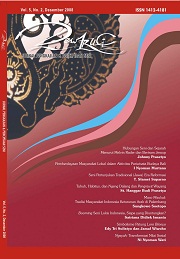SENI PERTUNJUKAN TRADISIONAL (JAWA) ERA REFORMASI
DOI:
https://doi.org/10.33153/dewaruci.v5i2.773Abstract
The aim of this study is to obtain a more in-depth explanation regarding the prob- lems in the life of classical Javanese performance from a sociological-artistic angle, in the face of changes that have occurred in the environment during the post Orde Baru era.  Nevertheless, in order to gain a clear picture about the changes during each era, this study also covers the life of classical Javanese performance during the two previous era, namely the era preceding the Orde Baru and the Orde Baru era itself.  This problem includes a general picture of the life of classical Javanese performance during these three periods, in particular at the time of this research. The next problem is concerned with the possibility of change occurring in the pat- tern of classical Javanese performances during the same period, and the nature of these new patterns, including which aspects, and with  what substance.  Likewise, to what extent are the aspects related to social change and  social phenomena re- flected in classical Javanese performance a response from the artist, in connection with preserving his existence.
In accordance with its goal, this study uses a sociological-artistic approach, from the  result of Arnold Hauser’s ideas in his book The Sociology of Art.  This ap- proach principally looks at the relation between a community and its art.  Classical Javanese performance is made up of a number of different elements, including its group, equipment, and audience.  Arnold Hauser explains that social changes in a given area will result in a unique artistic style, in accordance with the form of the community at that particular time.  An art form which in a certain period may be considered as a ritual art,  may have the potential to be used as a tool of propa- ganda by the authority or even emerge as a form of popular art.
Based on the results of the research, classical Javanese performance has a ten- dency  to  stand alone in each of the three eras, according to the changes in its environment.  During the era prior to the Orde Baru, classical Javanese was en- joyed mainly by the  agrarian community, who were influenced by arts from the court.  During the Orde  Baru era, performances were not only enjoyed by the agrarian community but also by the urban community as it spread to towns outside the court territory. At the present time, classical Javanese performances are coloured by government development policies and for  this reason are often used as a gov- ernment tool for conveying messages about  development.  In addition, during the Orde Baru era, other art forms began to penetrate and influence the form of clas- sical Javanese performance.  In the postOrde Baru era, its form has become more
open, as a result of the euphoria created by an excess of reformation, and it has become difficult to identify.  Furthermore, it is evident that audiences can no longer respond to the  moral messages conveyed in a classical Javanese performance.
Â
Key words:Â classical Javanese performance, group, audience.
Downloads
Downloads
Published
Issue
Section
License
Authors who publish in Dewa Ruci: Jurnal Pengkajian dan Penciptaan Seni agree to the following terms:
- Authors retain copyright and grant the Dewa Ruci: Jurnal Pengkajian dan Penciptaan Seni right of first publication with the work simultaneously licensed under a Creative Commons Attribution License (CC BY-SA 4.0) that allows others to share (copy and redistribute the material in any medium or format) and adapt (remix, transform, and build upon the material) the work for any purpose, even commercially with an acknowledgment of the work's authorship and initial publication in Dewa Ruci: Jurnal Pengkajian dan Penciptaan Seni.
- Authors are able to enter into separate, additional contractual arrangements for the non-exclusive distribution of the journal's published version of the work (e.g., post it to an institutional repository or publish it in a book), with an acknowledgment of its initial publication in Dewa Ruci: Jurnal Pengkajian dan Penciptaan Seni.
- Authors are permitted and encouraged to post their work online (e.g., in institutional repositories or on their website) prior to and during the submission process, as it can lead to productive exchanges, as well as earlier and greater citation of published work (See The Effect of Open Access).
This work is licensed under a Creative Commons Attribution 4.0 International License












